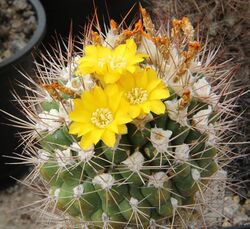Weingartia
Topic: Biology
 From HandWiki - Reading time: 4 min
From HandWiki - Reading time: 4 min
| Weingartia | |
|---|---|

| |
| Weingartia westii = Rebutia fidaiana subsp. fidaiana | |
| Scientific classification | |
| Kingdom: | Plantae |
| Clade: | Tracheophytes |
| Clade: | Angiosperms |
| Clade: | Eudicots |
| Order: | Caryophyllales |
| Family: | Cactaceae |
| Subfamily: | Cactoideae |
| Subtribe: | Rebutiinae |
| Genus: | Weingartia Werderm. |
| Species | |
|
See text. | |
| Synonyms[1] | |
| |
Weingartia is a genus in the family Cactaceae, with species native to Bolivia and Argentina . Molecular phylogenetic evidence suggests that it may be distinct from Rebutia. It is treated as a synonym of that genus by Plants of the World Online (As of September 2023),[2] but recognized as an alternative generic name in the third edition of the CITES Cactaceae Checklist. It may also be treated as Rebutia subg. Weingartia.[1]
Description
Plants usually solitary. Stems globose to oblong, to 20 cm high and 15 cm, rarely 30 cm in diameter, fresh green. Ribs 12 – 18, spiraling, forming distinct tubercles. Areoles on the tubercle in excentric position, sunken in its higher part. Spines more robust and thick, 7 – 35 in one areole, radial spines 1 – 3 cm long, central spines 3 – 4, to 5 cm long. Flowers borne near the stem tips, one areole can produce up to 3 flowers, golden yellow to orange to reddish yellow, 1 – 3 cm in diameter. Floral tube scales broad and imbricated. Fruits globose to ovoid, brownish. Seeds oblong, 1 mm long, black or brown.
Taxonomy
The genus Weingartia was designated in 1937 by Werdermann to replace invalid genus Spegazzinia Backeberg. All species of the genus Weingartia were transferred to the genus Rebutia by the International Cactaceae Systematics Group (ICSG) of the International Organization for Succulent Plant Study, a position also adopted by Plants of the World Online.[2]
A study in 2007 indicated that the genus Rebutia as then defined was polyphyletic. Sulcorebutia and Weingartia were kept as separate genera in the study; a summary cladogram for those species studied is shown below.[3]
| |||||||||||||||||||||||||||||||
Species formerly classified as Weingartia, Sulcorebutia and Cintia Kníže & Říha show a close relationship to each other. The larger group of species of Rebutia studied, those with hairy or bristly pericarpels, form a separate, more distantly related clade (Rebutia I). It has been suggested that these be excluded from the genus Rebutia.[3][4]
Species
Species accepted by the obsolete Plant List[5] are placed in Rebutia by Plants of the World Online (As of September 2023):[2]
- Weingartia fidaiana (Backeb.) Werderm. = Rebutia fidaiana (Backeb.) D.R.Hunt
- Weingartia kargliana Rausch = Rebutia neumanniana (Backeb.) D.R.Hunt
- Weingartia lanata F.Ritter = Rebutia neocumingii subsp. lanata (F.Ritter) D.R.Hunt
- Weingartia neocumingii Backeb. = Rebutia neocumingii (Backeb.) D.R.Hunt
- Weingartia neumanniana (Backeb.) Werderm. = Rebutia neumanniana (Backeb.) D.R.Hunt
- Weingartia westii (Hutchison) Donald = Rebutia fidaiana (Backeb.) D.R.Hunt subsp. fidaiana
Distribution
Andes mountains of central and south Bolivia and northwest Argentina at elevations of 1600 – 3600 m.[citation needed]
References
- ↑ 1.0 1.1 Hunt, David (2016). CITES Cactaceae Checklist (Third ed.). ISBN 978-0-9933113-2-1. https://www.kew.org/sites/default/files/2019-02/CITES%20Cactaceae%20Checklist%20Third%20Edition.pdf. Retrieved 2023-09-29.
- ↑ 2.0 2.1 2.2 "Rebutia K.Schum.." (in en). Royal Botanic Gardens, Kew. http://www.plantsoftheworldonline.org/taxon/295618-2.
- ↑ 3.0 3.1 Ritz, Christiane M.; Martins, Ludwig; Mecklenburg, Rainer; Goremykin, Vadim; Hellwig, Frank H. (2007), "The molecular phylogeny of Rebutia (Cactaceae) and its allies demonstrates the influence of paleogeography on the evolution of South American mountain cacti", American Journal of Botany 94 (8): 1321–1332, doi:10.3732/ajb.94.8.1321, PMID 21636499. Summary cladogram based on Fig. 2.
- ↑ Stefano Mosti, Nadeesha Lewke Bandara y Alessio Papini,Further insights and new combinations in Aylostera (Cactaceae) based on molecular and morphological data. Pak. J. Bot., 43(6): 2769–2785, 2011
- ↑ "Weingartia — The Plant List". http://www.theplantlist.org/browse/A/Cactaceae/Weingartia/.
Literature
- Augustin K.: Weingartia: history, description and reclassification. Cactus & Co. 7. (2): 91–126, 2003
- Ritter Fr.: Kakteen in Südamerika, Spangenberg, 1980.
- Anderson E. F.: The Cactus Family, Timber Press, Portland, Oregon, 2001.
Wikidata ☰ Q7702591 entry
 |
 KSF
KSF
